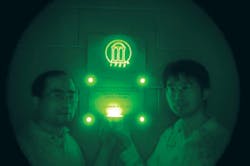FLUORESCENCE/BIOMEDICAL IMAGING: Long-glowing phosphor promises in-vivo imaging applications
In-vivo bioimaging is one of the applications promised by a new near-infrared (NIR) phosphor that glows for up to two weeks after a one-minute exposure to sunlight or even indoor fluorescent lighting. Unlike glow-in-the-dark materials for the visible region, which are relatively common, persistent IR phosphors have been difficult to develop. Researchers at the University of Georgia (Athens, GA) have used their new phosphor as the basis for nanoparticles that bind to cancer cells, and foresee other biomedical applications as well.
The scientists spent three years developing the material in order to extend the usual time of emission from a few milliseconds to multiple weeks—and are continuing to tweak it in an effort to further performance. While the trivalent chromium ion used in the emitter normally glows for just a few milliseconds, the new material’s chemical structure creates a labyrinth of traps that capture and store energy. As the stored energy is thermally released back to the chromium ions at room temperature, the compound persistently emits NIR light. The phosphors emit strongly between 650 and 1000 nm; peak wavelength depends on the exact composition.
1. Z. Pan, Y.Y Lu, and F. Liu, Nat. Mat., 11, 58–63 (2012).
More BioOptics World Current Issue Articles
More BioOptics World Archives Issue Articles

